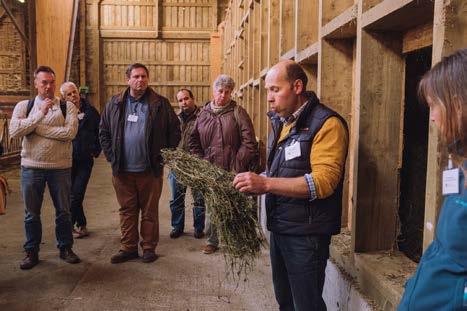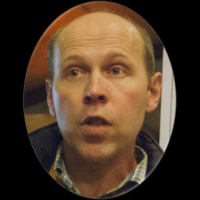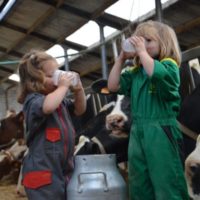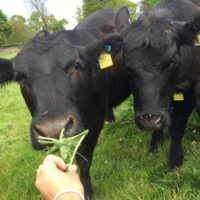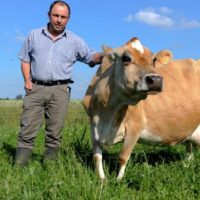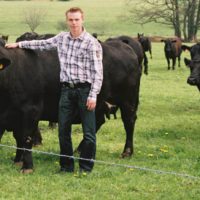Diversification for a sustainable and resilient husbandry system
Farm: “Ferme du Buis”
Location: Barry, Belgium
Case study
 Diversification for a sustainable and resilient husbandry system (.pdf)
Diversification for a sustainable and resilient husbandry system (.pdf)
Description
Background
The Boxwood farm – ‘la ferme du Buis’ – (mixed and dairy farming, 65 hectares of which 55 are in renting, 4 FTEs) has been transformed over the last 15 years from a conventional farm status producing for the industry (cereals, potatoes, beets) to the status of an organic farm, producing for the local market with direct sale.
Pierre Cossement and his wife Véronique set up a particularly efficient autonomous dairy production system, based on rapid rotational grazing, hay drying in barn, processing and marketing of products on the farm. The model, guided by the search for autonomy and a transversal and integrated vision of the different dimensions of the farm is innovative.
The motivation of Pierre and Véronique is mainly ethic: the search for autonomy allows to no longer participate in a destructive system. The financial aspect of their activities is therefore not the most important factor. They are in permanent reflection guided by the search for a coherence in their approach. Although they are already processing more than half of the milk produced, they are now developing a cellar project for the production of hard cheese. Their autonomy approach also has a positive impact on their investment capacity.
Summary of activities developed by the ‘ferme du Buis’:
- Dairy farming and processing of milk into cheese, butter, yogurt, ice cream, etc.
- Mixed and dairy farming (mainly Monbéliarde breed), milk production averages 6,500 kg of milk / cow / year
- Bed and Breakfast at the farm
- Shops on the farm
- Social integration farm
- Collaboration with the LAG / Natural Park of the Scheldt Plains, CARAH (a research and farm school), the network ‘innovative farms’
- Reception of trainees
- Woofing
Detailed description
- Feed autonomy:
- Rapid rotational pasture (24-48 hours): 30 plots for 9 months, regrowth time = 35-40 days depending on the specific flora of each plot. Sowing of aromatic plants (health and mineral supply)
- Hay drying in barn: double roof system, partly self-built (see video https://www.youtube.com/watch?v=9QiPJ45TS0E) – storage and retrieval by hay claw
- Seed autonomy (member of the peasant seed network)
- Financial and decision-making autonomy
- On-farm milk processing (butter, beaten / raw / pasteurized milk, yoghurt and fresh cheese)
- Sale of farm products on the farm
- Social farming (integration of disabled workers)
- Testing and development of new farming techniques
Results
The drying of hay in barn, combined with rotational grazing, are important factors of autonomy that favor animal health and the quality of milk for its processing into quality dairy products.
The practices implemented have allowed:
- Improve grassland quality (species composition, food value)
- Improve the health of dairy cows (no more use of antibiotics, for example)
- Jobs creation on the farm
- Implementation of production methods that are more respectful of the environment, the animal welfare and landscape;
- Increase revenue sources through the diversification of their activities and value synergies between revenue-generating activities;
- Get closer to the end customer by offering a quality product as part of a B2C model and thus strengthen the social links of the farm with its environment;
- Open the farm to different audiences and rely on a broad network of partners including peers, environmental associations, schools, etc.
Adoption criteria
- The willingness and conviction of the necessary change in the mode of production and marketing (permanent approach of autonomy in reaction to the conventional system in which the farmers delegate the production, the marketing of its products …) on the part of the farmers (motivation first of the farmer and his family)
- A favorable plot of land (land next around the farm, distributed around a concrete path)
- Regular confrontation with the experience and practices of other farmers
- A rigorous multidimensional organization: management of fences, permanent assessment of grass growth stage, dynamic management of the meadow and adaptation of livestock, efficient equipment to go quickly on all stages of hay drying (cutting, windrowing, etc.)
Future prospects
Climate change is more likely to favor the autonomous system put in place because it is more resilient because it is more complex and more diversified. Pierre and Véronique intend to pursue their autonomy approach by adapting livestock to a more rustic system (but deploring a lack of research on animals that value dried hay in barn) and the use of adapted forage seeds, currently poorly available (hence the need to produce oneself and / or collectively, without delegation to third parties …) and the transformation of all milk production on the farm;
There are still a number of things to think about: place of auxiliary plants in the system and optimal season calvings to match the “milk curve” and the grass growth curve in order to get dry cows during the winter.
Additional information
| Farming system | organic farming |
|---|---|
| Domains of innovation | farm system, forage conservation technique, forage mixture, grazing management system, landscape, marketing, product processing |
| Main types of animal | dairy cattle |
| Country | Belgium |
| Product type | Case study |
| Language | English |

